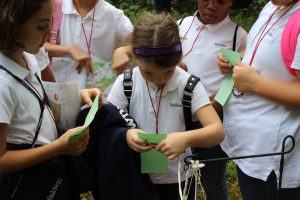Navigating the Outdoors

To view the photo-rich magazine version, click here.
Originally appears in the Summer 2019 issue.
IT WAS COLD AND RAINY, but my students were excited and engaged. Holding a GPS unit, they were intently looking for their next geocache. When I remarked that it was time to end class for the day, all of the students groaned and one exclaimed, “Can we stay outside longer and find more geocaches?” This hi-tech treasure hunt had my students willing to stay outside in the cold and the rain. As a teacher, a student asking to stay outside longer is not something I hear much anymore. Thirty years ago, it was not unusual to see children exploring the outdoors unsupervised. Today, when I talk to students about the exciting things they did over the weekend, very few mention spending time outside. Instead, they tell me about the latest video game they played or what their achievements were in a virtual world such as the one in the video game Fortnite. When I ask students about playing outside, some reply, “But it’s so boring outside,” while others express fear of the things that may harm them in the outside world. Children are spending less time outside than thirty years ago. Specifically, according to a recent study by the Seattle Children’s Institute, children from ages 10 to 16 are spending half the time playing outside that their parents did.1
So, what’s changed?
It’s easy to blame technology. My students will be quick to tell you all the technology they have access to, such as computers, tablets, cell phones, and gaming systems. Need to visit Grandma? Well, you can just call her on Facetime! Students today are more tech-savvy than ever. According to a 2017 study by Cellular Telecommunications Industry Associations (CTIA), 56 percent of children ages 8 to 12 in the United States own a smartphone. In the same study, 38 percent of children two and under are given a smartphone or tablet for entertainment.2
As an environmental educator, the reduced time in nature concerns me. Experts warn that we are replacing our strong connection with nature3 with increased screen time, which may negatively impact our students’ desire to participate in conservation, resulting in the development of a more toxic and polluted world.4 If my students are disconnected from nature, will they make positive conservation choices in the future? This article features a lesson used to engage third-graders in the outdoors.
This content is restricted to subscribers only.
If you are not yet a subscriber, please consider taking out a subscription here.
If you are an existing subscriber, kindly log in or contact us at info@greenteacher.com for more information.










